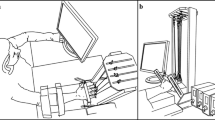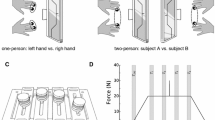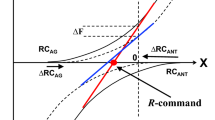Abstract
We have examined the interaction among individual finger forces in tasks that required the production of the total force by a subset of fingers in a particular direction in the flexion–extension plane. Nine subjects produced fingertip forces in a prescribed direction with a maximum voluntary contraction (MVC) effort and held the peak force for two seconds. Six finger combinations were tested, four single-finger tasks—Index (I), Middle (M), Ring (R) and Little (L)—one two-digit task (IM), and one four-digit task (IMRL). The subjects were asked to generate the finger forces in two directions, 0° (perpendicular to the surface of the transducer) and 15° toward the palm. In all task conditions, there were two experimental sessions, with and without visual feedback on the task force vector. The main findings were:
-
1.
The target direction significantly affected the constant error (CE) but not the variable error (VE) while removal of the feedback resulted in an increase in VE.
-
2.
The direction of the forces produced by fingers that were not explicitly required to produce force (enslaved fingers) depended on the target direction.
-
3.
In multi-finger tasks, the individual fingers produced force in directions that could differ significantly from the target direction, while the resultant force pointed in the target direction.
There was a negative co-variation among the deviations of the directions of the individual finger forces from the target direction. If a finger force vector deviated from the target, another finger force vector was likely to deviate in the opposite direction. We conclude that a multi-finger synergy is involved in the control of the finger force direction.









Similar content being viewed by others
References
Batschelet E (1981) Circular statistics in biology. Academic Press, New York
Latash M, Scholz J, Danion F, Schöner G (2002b) Finger coordination during discrete and oscillatory force production tasks. Exp Brain Res 146:419–432
Latash ML, Scholz JP, Danion F, Schöner G (2001) Structure of motor variability in marginally redundant multifinger force production tasks. Exp Brain Res 141:153–165
Latash ML, Scholz JP, Schöner G (2002a) Motor control strategies revealed in the structure of motor variability. Exerc Sport Sci Rev 30:26–31
Li ZM, Latash ML, Newell KM, Zatsiorsky VM (1998a) Motor redundancy during maximal voluntary contraction in four-finger tasks. Exp Brain Res 122:71–78
Li ZM, Latash ML, Zatsiorsky VM (1998b) Force sharing among fingers as a model of the redundancy problem. Exp Brain Res 119:276–286
Li Z-M, Pfaeffle HJ, Sotereanos DG, Goitz RJ, Woo SL-Y (2003) Multi-directional strength and force envelope of the index finger. Clin Biomech 18:908–915
Loevè M (1955) Probability theory. Van Nostrand, Princeton, NJ
Milner TE, Dhaliwal SS (2002) Activation of intrinsic and extrinsic finger muscles in relation to the fingertip force vector. Exp Brain Res 146:197-204
Santello M, Soechting JF (2000) Force synergies for multifingered grasping. Exp Brain Res 133:457–467
Schieber MH (1999) Somatotopic gradients in the distributed organization of the human primary motor cortex hand area: evidence from small infarcts. Exp Brain Res 128:139–148
Schieber MH (2001) Constraints on somatotopic organization in the primary motor cortex. J Neurophysiol 86:2125–2143
Schmidt RA, Lee TD (1999) Methodology for studying motor performance. In: Motor control and learning: A behavioral emphasis. Human Kinetics, Champaign, IL
Sharp WE, Newell KM (2000) Coordination of grip configurations as a function of force output. J Mot Behav 32:73–82
Shim J, Latash M, Zatsiorsky V (2003) Prehension synergies: trial-to-trial variability and hierarchical organization of stable performance. Exp Brain Res 152: 173–184
Valero-Cuevas FJ (1997) Muscle coordination of the human index finger. In: Ph.D. Thesis, Stanford University, Stanford
Valero-Cuevas FJ (2000) Predictive modulation of muscle coordination pattern magnitude scales fingertip force magnitude over the voluntary range. J Neurophysiol 83:1469–1479
Valero-Cuevas FJ, Zajac FE, Burgar CG (1998) Large index-fingertip forces are produced by subject-independent patterns of muscle excitation. J Biomech 31:693–703
Yokogawa R, Hara K (2002) Measurement of distribution of maximum index-fingertip force in all directions at fingertip in flexion/extension plane. J Biomech Eng 124:302–307
Zatsiorsky V, Latash M (2004) Prehension synergies. Exerc Sport Sci Rev 32:75–80
Zatsiorsky VM (2002) Kinetics of human motion. Human Kinetics, Champaign, Il
Zatsiorsky VM, Gao F, Latash ML (2003) Finger force vectors in multi-finger prehension. J Biomech 36:1745–1749
Zatsiorsky VM, Li ZM, Latash ML (1998) Coordinated force production in multi-finger tasks: finger interaction and neural network modeling. Biol Cybern 79:139–150
Zatsiorsky VM, Li ZM, Latash ML (2000) Enslaving effects in multi-finger force production. Exp Brain Res 131:187–195
Acknowledgments
Preparation of this paper was supported in part by NIH grants AR-048563, AG-018751, and NS-35032. The authors are grateful to Zbigniew Waskiewicz for his help in conducting the experiments and to Michelle L. Olson for her help in proofreading the manuscript.
Author information
Authors and Affiliations
Corresponding author
Rights and permissions
About this article
Cite this article
Gao, F., Latash, M.L. & Zatsiorsky, V.M. Control of finger force direction in the flexion-extension plane. Exp Brain Res 161, 307–315 (2005). https://doi.org/10.1007/s00221-004-2074-z
Received:
Accepted:
Published:
Issue Date:
DOI: https://doi.org/10.1007/s00221-004-2074-z




